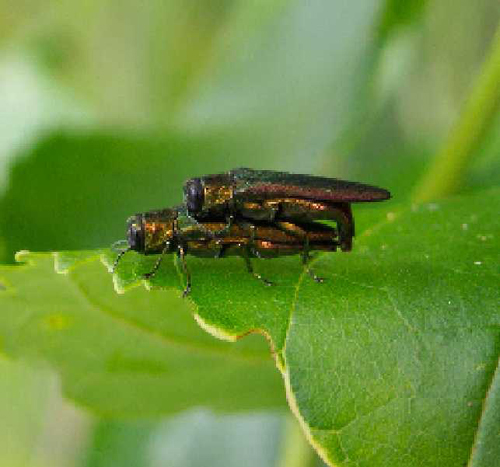Emerald Ash Borer Life Cycle / Effects
About EAB
The Emerald Ash Borer, (Agrilus planipennis fairmaire) is a small (1/2 inch long, 1/8 inch wide), metallic green beetle native to Asia. While it was first found in Michigan in 2002, it is likely that the beetle population had been established quite a few years before discovery.
Discovered in Kane County Illinois in 2006, the beetles’ presence has since been found in Boone, Bureau, Champaign, Cook, DeKalb, DeWitt, DuPage, Effingham, Grundy, Iroquois, Kankakee, Kendall, Lake, LaSalle, Marion, McHenry, McLean, Ogle, Stark, Will and Winnebago counties.
EAB’s natural spread is moderate, but its artificial spread can be rapid by people unwittingly transporting this pest through infested firewood and landscape waste. Artificial movement of infested trees has exacerbated the EAB problem in Illinois and North America.
To protect our Ash trees, it is our responsibility to minimize the spread of EAB by not transporting firewood outside of its local area. Fireplace owners should buy firewood from a known local source and burn all of it before May 1. Campers should buy firewood at your destination and be sure to burn all wood before leaving the campsite.
Actual size of EAB is very tiny and is no bigger than a penny. ( Only 1/2" x 1/8" )
Vertical Bark Splits or Fissures
EAB Life Cycle
The adult Emerald Ash Borer emerges May - July and the female lays numerous eggs in bark crevices and layers.
The eggs hatch in 7-10 days into larvae, which bore into the tree where they chew the inner bark and phloem, creating winding galleries as they feed. This cuts off the flow of water and nutrients in the tree, thereby causing the tree's dieback and death.

Ash Trees
Ash trees are very common in landscapes and most species, mainly White Ash (Fraxinus Americana) and Green Ash (F. pennsylvanica) are native to Illinois forests. It is estimated that as much as 20 percent of street trees in the greater Chicagoland area are Ash.
Characteristics of an Ash
- Compound leaves made up of seven small, glossy green leaflets (5-9 leaflets).
- Leaves, twigs and branches grow symmetrically in opposite pairs.
- Bark of mature trees is gray and furrowed, often appearing in a diamond pattern.
- Some Ash trees will produce small canoe paddle-shaped seeds.
- Seedless Ash trees are common.
- Some Ash produce conspicuous hard, brown “flower galls” on their twigs.
Signs & Symptoms of EAB
The most visible sign of infestation is crown dieback. Branches at the top of the crown will die and more branches will die in subsequent years. As the tree declines, ‘suckers’, or new young branches, will sprout from the base of the tree and on the trunk.
The bark may also split vertically and woodpeckers may feed on the beetle leaving visible damage on the bark. Successful treatments with insecticides are limited but continue to be studied. All Ash trees near any new infestation will most likely become infested and die.
Adult beetles emerging from trees will leave a unique “D” shaped exit hole. This is a small 1/8 inch diameter distinctly “D” shaped hole that may appear anywhere on the trunk or upper branches.
EAB D-Shaped Emergence Hole ( Actual size 1/8" and D-shaped )
Other Stressors
Ash trees may suffer from a number of insect disease or other problems that can cause similar symptoms. Native borers also attack Ash trees and leave different exit holes. The round or oval holes of native insect borers are not “D” shaped and are usually smaller or larger than those of the EAB.
How to Identify EAB

